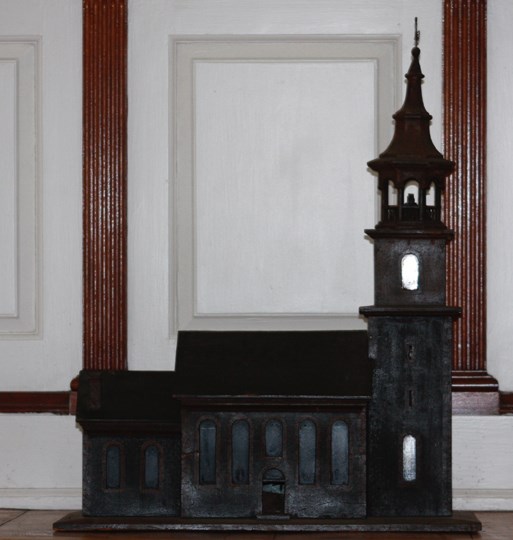Last updated: January 11, 2022
Article
19th century Models of the Church: History and Commemoration

National Park Service
19th-century Models of the Church: Commemoration & History
A pair of small wooden models displayed in large pews at the front of St. Paul’s Church suggests an earlier version of commemorating history. They were constructed in 1865 as part of a celebration of two milestones in the history of St. Paul’s. It marked the 100th anniversary of the beginning of the construction of the church, evident by the 1765 cornerstone still visible over the outside door at the western wing of the edifice. Additionally, the congregation was celebrating the 60th anniversary of the consecration of the house of worship.
The commemoration featured a landmark discourse by the Rector, Father William S. Coffey, which, in its archived, printed form, remains an important source for the study of the early history of the parish. There were also refreshments and a special religious service. Fortunately, for our understanding of the church’s past, a local, 46-year-old carpenter named Joseph Mager contributed to the anniversary by constructing two small but remarkable models, which survive and are now regarded as artifacts and wonderful sources of history.
They represent the church -- exterior -- as it appeared in 1865, the last year of the Civil War. The basic contours are similar to the edifice witnessed by today’s visitors. The eastern wing, for instance, added in the mid 1850s, ten years prior to Mager’s models, is there. Mager, however, depicts clear windows; religious scenes represented on colorful stained glass were introduced in 1870. The most interesting differences -- and the singular use of the models as a representation frozen in time -- are closer to the top. Mager’s models represent the wooden roof placed in the 1700s. Today’s viewers see a slate roof, which was installed in the 1870s, a major progression for the day.
More importantly, Mager’s careful work captures the airy, largely open wooden cupola which was erected in the late 1780s when the church was completed after the Revolutionary War. The church bell functioned as a vital form of communication with the neighborhood. The open belfry permitted a wider circulation of the chimes and gongs alerting residents to fires, funerals, church service, special occasions, and, as required, the One of the models of the church constructed for the centennial celebration of 1865. passing hours of the day. Union victories in the Civil War and the death of President Lincoln were announced through this means of communication.
Additionally, Mager showed the weather cock atop the spire of the steeple, reflecting speed and direction of the wind. An important tool in what remained a largely agricultural community, the weather vane provided information useful to farmers considering whether to plant seed on a given day, when almanacs were about the only available weather reports. Too, St. Paul’s Episcopal Church remained, like many American protestant churches, reluctant to display a Christian cross, viewed as a vestige of Roman Catholicism.
About 20 years later, in 1887, the aging, weather-beaten, lightning-damaged wooden cupola was dismantled, replaced by the stone and brick steeple extant today, and capped with a Cross, reflecting the fading farming character of the community as well as the influence of a religious reform impulse usually called the Oxford Movement. Began in England, and affecting almost all Episcopal Churches in America, the Oxford movement stressed a return to elements of the Christian heritage that had been omitted during the Protestant Reformation, including the display of the Cross.
Some stabilization was performed on the models in the late 1990s, but they are largely original versions of Mager’s work, and available for viewing by today’s visitors to St. Paul’s Church National Historic Site
